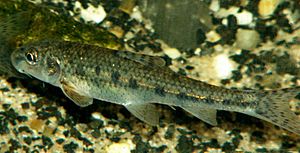Gudgeon facts for kids
Quick facts for kids Gudgeon |
|
|---|---|
 |
|
| Conservation status | |
| Scientific classification | |
| Synonyms | |
|
The gudgeon (scientific name: Gobio gobio) is a small fish. It belongs to the Cyprinidae family, which includes carps and minnows. You can find gudgeons in fresh water across central and temperate parts of Europe and Asia.
This fish loves streams and lakes with sandy bottoms. Gudgeons are social fish, meaning they like to live in groups. They eat small creatures that live on the bottom of the water. A gudgeon can live for up to five years. Most gudgeons are about 12 cm long, but some can grow a bit bigger.
Contents
What Does a Gudgeon Look Like?
The gudgeon has a long, thin, and rounded body. It usually grows to be about 9 to 13 cm long. Some gudgeons can even reach up to 21 cm!
Key Features of the Gudgeon
- It has short fins on its back and underside. These fins do not have jagged edges.
- There's a small whisker-like barbel at each corner of its mouth. These help it find food.
- Its head is wide and flat, with a blunt snout. The lower jaw is shorter than the upper one.
- It has fairly large scales, with about 40 to 45 along its side.
- The gudgeon has a large swim bladder, which helps it float.
Gudgeon Colors and Markings
Gudgeons are usually greenish-brown on top. Their sides are silvery. They have a row of six to twelve faint dark spots along their body. Their belly is white. The fins on their chest, belly, and underside are grayish-white with a brownish tint. The fins on their back and tail are pale brown with darker spots.
Where Do Gudgeons Live?
Gudgeons live in freshwater systems that flow into the eastern Atlantic Ocean. You can also find them in rivers that drain into the North Sea and Baltic Sea. This includes rivers like the Loire in France and the Rhône. They are also found in the upper Danube and parts of the Dniestr, Bug, and Dniepr rivers that flow into the Black Sea. It's not fully clear how far into Asia they spread. They prefer lakes, rivers, and streams of all sizes, especially those with sandy or gravelly bottoms.
Gudgeon Behavior and Life Cycle
Gudgeons swim in groups called shoals. They usually stay near the bottom, looking for food. They eat worms, water insects, larvae, small snails, and even fish eggs and young fish. Gudgeons are most active during the day.
Communication and Sounds
These fish can make squeaking sounds. Scientists believe these sounds help gudgeons talk to each other.
Reproduction and Young Gudgeons
Gudgeons lay their eggs in shallow water over stones. They breed from April to August when the water is warm, above 13 °C. The eggs are released and float for a bit before sticking to the bottom. Baby gudgeons and young fish eat tiny bits of dead plants and animals found on the bottom. In their first year, young gudgeons can grow to about 12 cm. As mentioned, they can live for up to five years.
Who Eats Gudgeons?
Gudgeons are a common meal for many animals that eat fish. This includes animals like the Eurasian otter and the common kingfisher. In Central Europe, gudgeons make up a large part of the kingfisher's diet. They are often 25% to 35% of the fish a kingfisher eats. One study showed that gudgeons were over 80% of the fish an otter ate in a stream in the Czech Republic.
Gudgeon Status
The gudgeon is found in many places and there are lots of them. There are no major threats to this fish. Because of this, the IUCN (International Union for Conservation of Nature) says the gudgeon is of "Least Concern". This means they are not worried about it becoming endangered.


